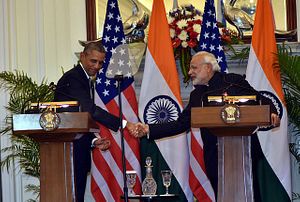He came, he saw, he conquered — this is how one can describe U.S. President Barack Obama’s Tuesday meetings with India’s elite in New Delhi. People started gathering in the Siri Fort auditorium, located in the center of Delhi, more than three hours ahead of the event’s scheduled start. The uncomplaining crowd felt privileged to be the audience for the world’s most powerful man.
“After all, you don’t get to hear a U.S. president and top of that, Barack Obama, every time in your life. It’s a once in a life time opportunity to see him live and witness his oratory. I came to the gate of the auditorium at 6:30 in the morning. I didn’t want to take a chance with my luck,” said Poonam Sharma, a college student.
The audience waited with bated breath for Obama’s entry into the hall. Once he stepped in, the whole auditorium gave him a rousing welcome. The president had to ask everyone to resume their seats. For around 35 minutes, the crowd lapped up each and every sentence he uttered. Like a magician, the American leader kept the Indian audience spellbound. Once the speech was over, the dazed spectators were not willing to let him go. Everyone wanted to shake hands with the president. For 15 minutes, Barack Obama and his wife, Michelle, got lost in the crowd; even his security detail had a tough time keeping an eye on him. It took a little effort from the president to extract himself from the crowd and bid a quick goodbye to an overly excited gathering.
For three days, the whole nation seemed to be under Obama’s spell. His personality created much excitement among the masses. It was, for example, really amazing to see so many people queuing up to witness the Republic Day parade on January 26th despite the biting cold and uncomfortable drizzle in New Delhi.
“I don’t care about the rain. I am just keen to see Obama,” was the refrain of the majority who were going to attend the celebrations.
On one level, the summit-level talks between Indian Prime Minister Narendra Modi and Obama were more about personalities than about specific issues. The issues took a back seat and personalities dominated the Indian media.
What drew great attention was Modi’s choice of clothes. A suit that the Indian prime minister wore on the first day of Obama’s visit became a particular talking point as the pinstripes on the suit spelled out Modi’s name over and over again. Additionally, the media was abuzz about Modi’s many wardrobe changes during the visit. Obama’s car and his official plane were hot topics of discussion as well.
The body language of the leaders and their mannerisms also attracted considerable attention. Speculation over images led to all kinds of interpretations by the press. Modi was lauded for his ability to see eye to eye with the American President. Even his manner of shaking Obama’s hand was discussed and dissected.
Style, therefore, dominated over substance — at least in the Indian media. Sensational coverage of the non-political parts of the summit almost submerged the real agenda and substance.
No one bothered to investigate the real content of the new nuclear deal. No one asked what a $4 billion dollar promise in investments and loans will mean for India. No one questioned the consequences of Indo-U.S. proximity for stability in South Asia and the Asia-Pacific region more generally.
On one level, it seems that Obama’s visit has optic value more than anything. People in large seem to be happy, however, that Obama came as the chief guest for India’s Republic Day parade. Modi understands the fancies of middle-class India. An American president’s grand declamations and praise for the country satisfy the ego of India’s new middle class and the youth who want to see India emerge as a powerful nation in the world.
By hosting Obama on India’s most important day, the Indian prime minister honors the impatience of the urban middle-class which voted overwhelmingly for the the BJP leader in last year’s general elections.
When Obama came down from the podium after delivering the speech at Siri Fort auditorium and mingled with the crowd, there was a mad rush to shake hands and take selfies with the U.S. leader. The crowd was hypnotized. They were ecstatic that the American president had just said that he believed India could be among the United States’ “best partners.”
Once the dust settles down and fine print of the nuclear deal comes out, the reality will strike the people. For the time being, people in Delhi are feeling relieved that Obama has left India. Finally, they can relax and drive around their own city without getting stuck in any security drills! The people can now claim their republic.

































